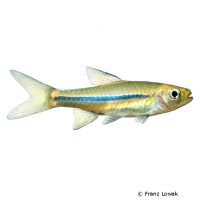Blue Line Rasbora (Rasbora sarawakensis)
| Blue Line Rasbora Rasbora sarawakensis | |
|---|---|
| Name | Blue Line Rasbora |
| Name Lat. | Rasbora sarawakensis |
| Family | Danios |
| Family lat. | Danionidae |
| Order | Carps |
| Order lat. | Cypriniformes |
| Origin | Borneo |
| Habitat | Forest streams |
| Diet | Carnivore |
| pH | 6.0-7.5 |
| Behavior | Peaceful |
| Keeping | Group, school |
| Care Level | Easy |
| Reproduction | Egg scatterer |
| Breeding | Moderately difficult |
| Life Span | N/A |
| Protection | No |
| Metric Units | |
| Size | 5 cm |
| Temperature | 22-26 °C |
| Hardness | 2-12 °dH |
| Aquarium | ~ 100 l |
| US Units | |
| Size | 2" |
| Temperature | 72-79 °F |
| Hardness | 36-214 ppm |
| Aquarium | ~ 25 gal |
Distribution and habitat
The Sarawak Rasboras are found on the island of Borneo in Sarawak (Malaysia) and Kalimantan (Indonesia). There they live mostly in slow-flowing forest streams with muddy, leafy bottoms and dense underwater vegetation.
Maintenance
The aquarium should have a dense border planting, with hiding and retreat possibilities (roots) and offer much free swimming space. A dark substrate covered with some foliage (e.g. sea almond leaves), shaded light (floating plants) and soft, slightly acidic water is ideal.
No ammonia, ammonium and nitrite should be detectable, the nitrate value should not exceed 100 mg/l. To ensure the water quality and oxygen content, a filter and heater adapted to the aquarium size is required, as well as lighting for the species-appropriate day-night rhythm of the animals.
Diet
In nature they feed mainly on insects and insect larvae. The food supply consists of live, frozen and dry food. For a balanced diet, feed once a day with a high-quality, protein-rich dry food (flakes, granules, pellets) as well as cyclops, moina, daphnia, artemia, mosquito larvae, etc. (live or frozen)
It is recommended to feed small portions several times a day. Only feed as much as will be eaten within a few minutes. A regular and varied diet promotes health and prevents deficiency symptoms.
Behaviour and compatibility
They are lively and very peaceful schooling fish that are well suited for a community tank with other peaceful fish. A group of at least 8-10 individuals, but preferably more, should always be kept together. In a too small group they remain shy and colorless.
Basically, only compatible fish species with similar demands on water condition and water temperature should be socialized.
Sex dimorphism
The sexes are difficult to distinguish. The somewhat smaller males are slimmer and more intensely colored than the more rounded appearing females.
Reproduction and breeding
They are free spawners. The female spawns between fine plants (Java moss) near the bottom. The larvae hatch after 24-48 hours and swim freely after about 3 days. The parents do not perform brood care and should be separated from the fry after spawning, as they are spawn predators.
Fry must be fed several times a day with special rearing food (Artemia nauplii, microworms, dust food). In a community tank breeding is hardly possible, because the spawn is easy prey.
Important
The foliage (sea almond tree, oak, etc.) enriches the water with humic substances and naturally lowers the pH
The well-being of the fish should be checked regularly. The temperature should be checked daily, the pH, hardness and nitrate value at least every 14 days. Regular partial water changes are recommended, even if the contaminant level has not yet reached the upper limit. Sudden changes in water quality should be avoided. Newly introduced fish must be accustomed slowly to the water in the aquarium
Further literature can be found in your pet store.
References
Text: petdata; Image: Franz Lowak
Source: BMELV (1998): Tierschutzgutachten - Haltung von Zierfischen (Süßwasser); ENGELMANN (2005): Zootierhaltung - Tiere in menschlicher Obhut: Fische, Verlag Harri Deutsch
- Gemäß § 21 Abs. 5 Tierschutzgesetz idgF
